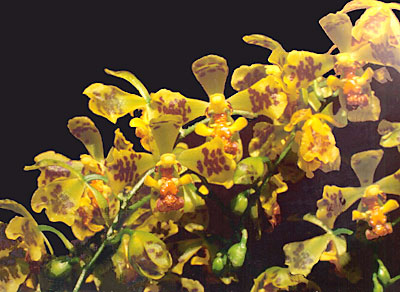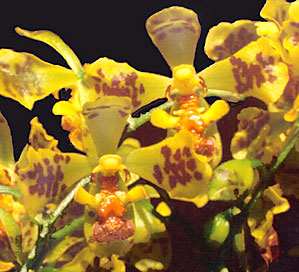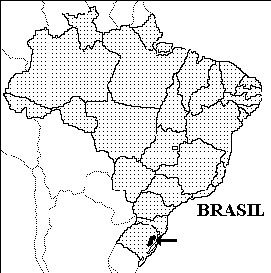 |
||
 |
||
| Oncidium
X cassolanum V. P. Castro & Campacci hibr. nat. nov. A new Oncidium hybrid in the section Walueva found in the south region of Brazil |
||
 |
||
Diagnose
Latine: Herba hybrida naturalis inter Oncidium riograndense Cogn.
et Oncidium cornigerum Lindl. Floribus medis inter haec species. |
| Type:
Brazil - Rio Grande do Sul, in "Vale dos Sinos", near to Novo
Hamburgo city. Collector: (Who found the plant) Oswaldo Cassola, 1990. This species bloomed in cultivation in 1991 and the following years. Holotypus: SP |
Plant
epiphyte, with caespitosus growing, natural hybrid between Oncidium riograndence
Cogn. and Oncidium cornigerum Lindl. Vegetative characteristic: inflorescence
and flowers similar to the progenitor. Flowers: sepals, petals and lip are
yellow with brown blotches, color varies from one specimen to another. Dorsal
sepal is elliptic-lanceolate, 14,0mm long and 6.0mm wide. Lateral sepals:
14,0mm long and 6,0mm wide, with agglutinated synsepalous base. Petals:
oblong-lanceolate, 15,0mm long et 7,0 wide. Lip: trilobated, 12,0mm long
and large when distends, with a complex callus that varies between the 2
species that originated the hybrid; In the analyzed specimen, the callus
is formed from the base, by a sequence of superposed chestnut brown plaques;
then there are two small yellow corns turned towards the tip; between the
lateral lobes of the lip, there are 2 divergent elevated masses and then,
between those elevated masses and towards the mid-lobe, there is a mass
of small dissociated warty calli. There is no callus in the mid-lob (a characteristic
of Oncidium cornigerum). Column:auriculate, pilosus (hairy) at the base
and at the wings; 5,0mm long, yellow with brown blotches in the wings. Anther
: yellow, 2,0mm long. Pollinia :2, yellow, long caudicle, 2,0mm long. |
|
Distribution:
State of Rio Grande do Sul - Brazil Other regions: State of de Santa Catarina - Brazil and recently it was also found in the region of Missiones in Argentine. Habitat: Humid forests of "Vale dos Sinos" in altitude above 300m. |
Etymology:
To pay homage to Mr. Oswaldo Cassola, already dead, who discovered this
natural hybrid at the beginning of the 90 years. Observations: The specimen used for the description and the holotypus has been given for Mr. Paulo Strumiello to us. We thank him very much. Discussion: It is evident that concerning a natural hybrid, the specimen should take the intermediate characteristic of the ascendants, Oncidium riograndense Cogn and Oncidium cornigerum Lindl., Those species are found in the same region and bloom at the same time, thus the hybridization. |
 |
|
|
back
